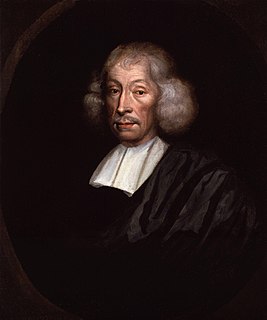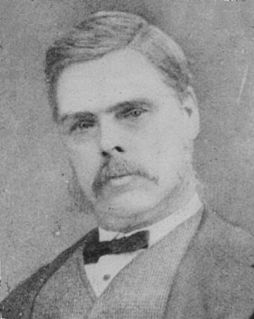
John Ray FRS was a Christian English naturalist widely regarded as one of the earliest of the English parson-naturalists. Until 1670, he wrote his name as John Wray. From then on, he used 'Ray', after "having ascertained that such had been the practice of his family before him". He published important works on botany, zoology, and natural theology. His classification of plants in his Historia Plantarum, was an important step towards modern taxonomy. Ray rejected the system of dichotomous division by which species were classified according to a pre-conceived, either/or type system, and instead classified plants according to similarities and differences that emerged from observation. He was among the first to attempt a biological definition for the concept of species, as "as a group of morphologically similar organisms arising from a common ancestor". Another significant contribution to taxonomy was his division of plants into those with two seedling leaves (dicotyledons) or only one (monocotyledons), a division used in taxonomy today.

Thomas Caverhill Jerdon was a British physician, zoologist and botanist. He was a pioneering ornithologist who described numerous species of birds in India. Several species of plants and birds including Jerdon's baza, Jerdon's leafbird, Jerdon's bushlark, Jerdon's nightjar, Jerdon's courser, Jerdon's babbler and Jerdon's bush chat are named after him.

The Oriental magpie-robin is a small passerine bird that was formerly classed as a member of the thrush family Turdidae, but now considered an Old World flycatcher. They are distinctive black and white birds with a long tail that is held upright as they forage on the ground or perch conspicuously. Occurring across most of the Indian subcontinent and parts of Southeast Asia, they are common birds in urban gardens as well as forests. They are particularly well known for their songs and were once popular as cagebirds.

Major-General Thomas Hardwicke was an English soldier and naturalist who was in India from 1777 to 1823. He collected numerous specimens of natural history and had them painted by Indian artists. From these paintings many new species were described. Several of these species are named after him. On returning to England he collaborated with the zoologist John Edward Gray to publish Illustrations of Indian Zoology (1830–1835).
James Petiver was a London apothecary, a fellow of the Royal Society as well as London's informal Temple Coffee House Botany Club, famous for his specimen collections in which he traded and study of botany and entomology. He corresponded with John Ray and Maria Sibylla Merian. Some of his notes and specimens were used by Carolus Linnaeus in descriptions of new species. The genus Petiveria was named in his honour by Charles Plumier. His collections were bought by Sir Hans Sloane and became a part of the natural history museum.

John Woodward was an English naturalist, antiquarian and geologist, and founder by bequest of the Woodwardian Professorship of Geology at the University of Cambridge. Though a leading supporter of observation and experiment in what we now call science, few of his theories have survived.

Francis Day was an army surgeon and naturalist in the Madras Presidency who later became the Inspector-General of Fisheries in India and Burma. A pioneer ichthyologist, he described more than three hundred fishes in the two-volume work on The Fishes of India. He also wrote the fish volumes of the Fauna of British India series. He was also responsible for the introduction of trout into the Nilgiri hills, for which he received a medal from the French Societe d'Acclimatation. Many of his fish specimens are distributed across museums with only a small fraction deposited in the British Museum, an anomaly caused by a prolonged conflict with Albert Günther, the keeper of zoology there.
Driftwood Canyon Provincial Park is a provincial park in British Columbia, Canada. Driftwood Canyon Provincial Park covers 23 ha of the Bulkley River Valley, on the east side of Driftwood Creek, a tributary of the Bulkley River, 10 km northeast of the town of Smithers. The park is accessible from Driftwood Road from Provincial Highway 16. It was created in 1967 by the donation of the land by the late Gordon Harvey (1913–1976) to protect fossil beds on the east side of Driftwood Creek. The beds were discovered around the beginning of the 20th century. The park lands are part of the asserted traditional territory of the Wet'suwet'en First Nation.

Georg Joseph Kamel was a Jesuit missionary, pharmacist and naturalist known for producing the first comprehensive accounts of Philippine flora and fauna and for introducing Philippine nature to the European learned world. A number of Kamel's treatises were published in the Philosophical Transactions, while his descriptions of Philippine flora appeared as an appendix to the third volume of John Ray's Historia Plantarum.

Patrick Russell was a Scottish surgeon and naturalist who worked in India. He studied the snakes of India and is considered the "Father of Indian Ophiology". Russell's viper, Daboia russelii, is named after him.

Robert Wight MD FRS FLS was a Scottish surgeon in the East India Company, whose professional career was spent entirely in southern India, where his greatest achievements were in botany – as an economic botanist and leading taxonomist in south India. He contributed to the introduction of American cotton. As a taxonomist he described 110 new genera and 1267 new species of flowering plants. He employed Indian botanical artists to illustrate many plants collected by himself and Indian collectors he trained. Some of these illustrations were published by William Hooker in Britain, but from 1838 he published a series of illustrated works in Madras including the uncoloured, six-volume Icones Plantarum Indiae Orientalis (1838–53) and two hand-coloured, two-volume works, the Illustrations of Indian Botany (1838–50) and Spicilegium Neilgherrense (1845–51). By the time he retired from India in 1853 he had published 2464 illustrations of Indian plants. The standard author abbreviation Wight is used to indicate this person as the author when citing a botanical name.
Lieutenant Colonel Edward Frederick Kelaart was a Ceylonese-born physician and naturalist. He made some of the first systematic studies from the region and described many plants and animals from Sri Lanka.
Joseph Dandridge, was an English silk-pattern designer of Huguenot descent, a natural history illustrator, an amateur naturalist specialising in entomology, and a leading figure in the Society of Aurelians of which he was a founder member.

James Anderson was an 18th-century Scottish physician and botanist. In 1783 he was a joint founder of the Royal Society of Edinburgh. In 1794, he was elected to the American Philosophical Society in Philadelphia, Pennsylvania. He spent his later life in India.

Therea petiveriana, variously called the desert cockroach, seven-spotted cockroach, or Indian domino cockroach, is a species of crepuscular cockroach found in Sri Lanka. They are members of a basal group within the cockroaches. This somewhat roundish and contrastingly marked cockroach is mainly found on the ground in scrub forest habitats where they may burrow under leaf litter or loose soil during the heat of the day.
Benjamin Heyne FLS was a German botanist, naturalist, and surgeon who worked in British India as a Botanist to Samalkot in the Madras Presidency under the British East India Company. He collected and described plants from southern India, many of which were named after him by European botanists.
Charles Dubois or Charles du Bois, was treasurer to the East India Company and a botanist. He corresponded with other naturalists including James Petiver, William Sherrard and Hans Sloane and was famous for maintaining a garden with interesting plants from the colonies. He was instrumental in introducing rice cultivation in North America.

Surgeon General George BidieCIE was a British physician who worked in India in the Madras Medical Service. He was also Superintendent of the Government Museum, Chennai from 1872 to 1885.
Samuel Browne or Brown was an English surgeon and botanist. He worked in the English East India Company factory at Fort St. George, Madras. Aside from his work he collected specimens of the local plants, especially grasses, along with vernacular names and made notes on their applications in medicine and other traditional use. He corresponded with several other contemporary naturalists including John Ray, Georg Joseph Kamel and James Petiver.













